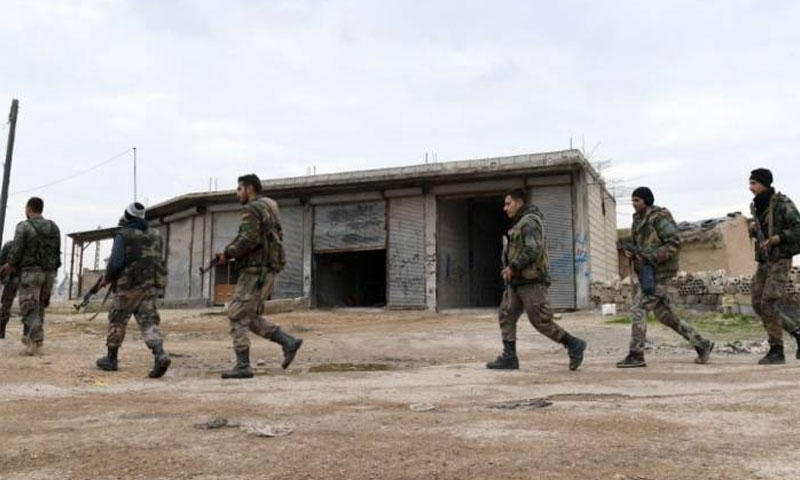



The Syrian regime forces have continued to follow the divide-and-conquer tactic to make advances in opposition-held Idlib and rural Aleppo in northern Syria.
Al-Assad has adopted the divide and conquer strategy before. In the past years, al-Assad used this strategy to claw back control over the Eastern Ghouta enclave. In fact, this military tactic is based on splitting the battlefronts and taking over the rebel-held territory in a sequential manner. Moreover, the Syrian regime launches fierce attacks with the support of the Russian airpower on the rebel-held areas to further weaken the opposition factions.
On the other hand, the armed opposition factions have not been able to thwart al-Assad’s divide and conquer strategy. They only carry out raids and vehicle bomb attacks against the Syrian regime forces to deplete their sources.
The Syrian regime has recently used the divide and conquer strategy in its battle in the southern countryside of Aleppo after it failed to make any gains or advances on the ground in the western countryside of Aleppo due to the resistance of the armed opposition factions of the Syrian “National Army,” (SNA) “Hay’ at Tahrir al-Sham” (HTS), as well as the “Turkistan Islamic Party.”
The Syrian regime forces began a military offensive to take control of the international highway between Damascus and Aleppo via the following two fronts. The Syrian regime fighters mounted an offensive military operation on the fronts of the eastern and southern Idlib countryside, where they were able to regain control of the strategic cities of Maarat al-Numan and Saraqib. The city of Saraqib straddles the intersection of the major M4 and M5 highways, one linking the capital Damascus to the north and another connecting Syria’s coast with the country’s east.
At the same time, the Syrian regime fighters staged another attack against the opposition factions in the western countryside of Aleppo to capture the outskirts of the international highway; however, the opposition factions were able to avert the regime attack and place their weight in the battle. After intensive clashes with the opposition factions for two weeks, the Syrian regime failed to make progress and managed to take over only small areas such as al-Rashideen 5. Still, battles are currently taking place at the al-Rashideen four front and the-Sahfiiyn Association.
The National Liberation Front and the HTS announce on a daily basis that heavy losses take a toll on the al-Assad forces and the pro-regime militias in the southern and western countryside of Aleppo.
Nevertheless, the state-owned media outlets have not made any public report about the losses of the Syrian regime. In contrast, the pro-regime pages and news networks regularly mourn the deaths in battles.
The repelling of the opposition factions to the Syrian regime forces prompted the diversion of the battle compass to the southern countryside of Aleppo. The regime forces began to rapidly control the villages and towns of the region, including Zaitan and Berna. Moreover, the Syrian regime forces reached the town of al-Eis and its hill, which includes a Turkish observation post. They surrounded it unconcerned by the threats of Turkish President Recep Tayyip Erdogan.
Erdogan has threatened to launch a large-scale military operation in the province of Idlib if the Syrian regime forces, backed by Russia airpower, continue to advance and encircle the Turkish observation military posts.
Erdogan said in a speech to deputies of the ruling Justice and Development Party (AKP) bloc in Ankara last week that “our air and ground forces will move when needed freely in all our areas of operations and Idlib, and they will carry out military operations if necessary.”
Erdogan gave the Syrian regime until the end of February to withdraw behind the Turkish observation posts in the Idlib de-escalation zone in northern Syria until the end of February. However, the Syrian regime forces neglected Turkish threats. They continued to advance, with the support of the Russian air force, pending Turkey’s response and the implementation of its threats.
Question have been raised about the reasons why the Syrian regime forces made rapid advances in the southern countryside of Aleppo and the eastern countryside of Idlib and why the armed opposition factions did not have heavy weapon on the fronts of rural Aleppo, which was evident in a recording published by the “Turkestan Islamic Party,” via its media platform, “Voice of Islam,” on 7 February.
The recording shows that the opposition factions used heavy weapons in the battles that took place in rural Aleppo, including rocket launchers, artillery shells, anti-aircraft guns, anti-tank systems, and anti-armor missiles.
The use of heavy weapons was evident in Aleppo amid their absence from the fighting fronts in Idlib and its countryside. An SNA leader in rural Idlib, who spoke on condition of anonymity, said to Enab Baladi earlier that “the HTS” withdrew its heavy arms from the fronts of Idlib to the western countryside of Aleppo.
However, the communications director at HTS, Taqi al-Din Omar, emphasized that the heavy weapons in the fronts of Idlib are used more intensively from all other fronts. Omar added what is rumored about the withdrawal of heavy weapons from Idlib is incorrect.
He pointed out, in an earlier interview with Enab Baladi, that the nature of the battle in Idlib, the presence of drones above Idlib, as well as the second party’s possession of a very precise striking machines of targets, led to “a logistical change in moving and securing the heavy weapons and their disembarkation at the appropriate time and place on the battlefield.”
The regime forces are expected to continue their progress to control the international highway “M5”, waiting for the new Turkish-Russian understandings. The negotiation of the new Turkish-Russian agreements began last Saturday upon the arrival of a Russian delegation to Ankara.
if you think the article contain wrong information or you have additional details Send Correction